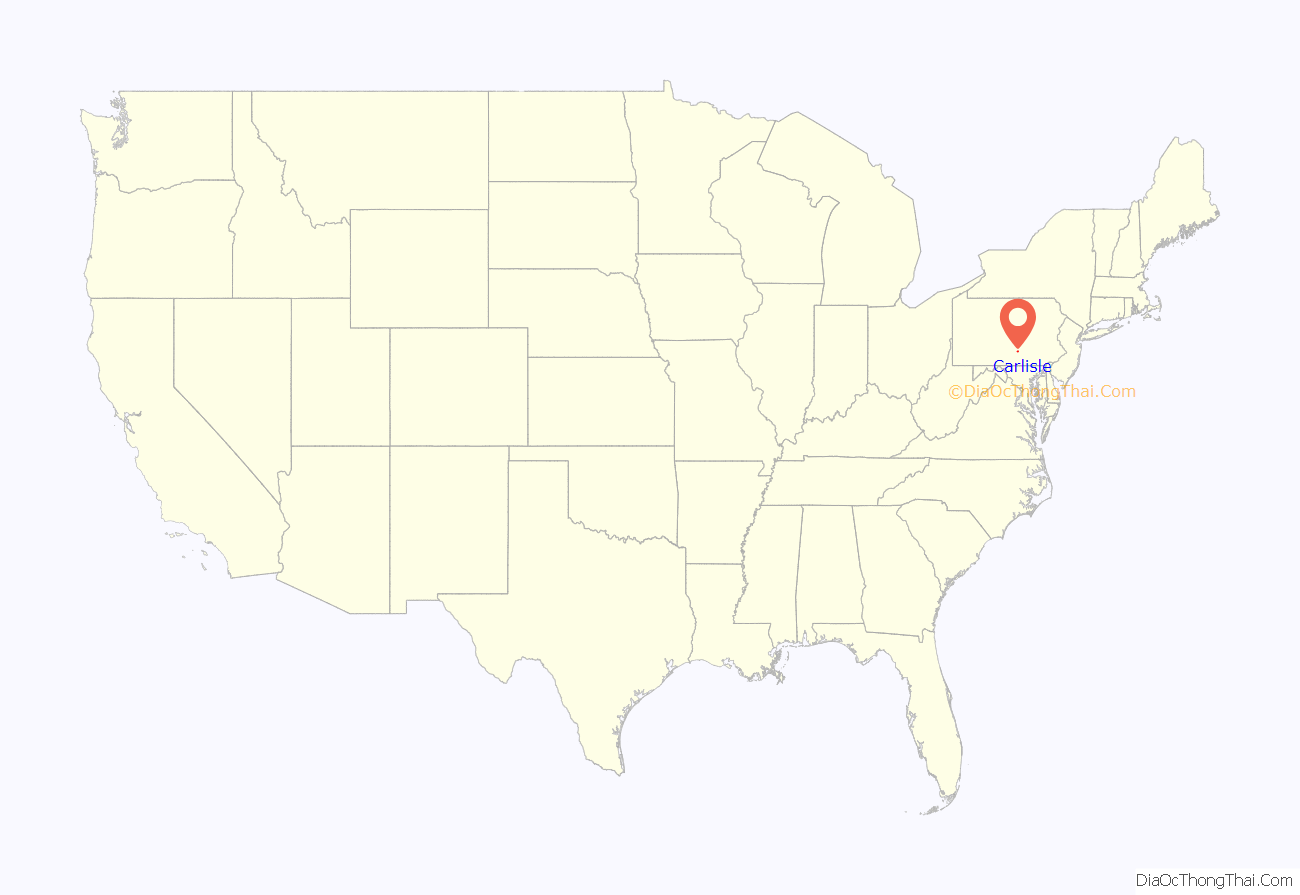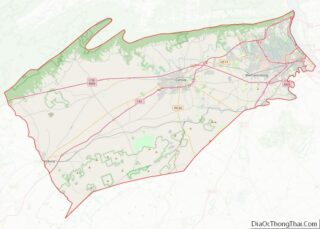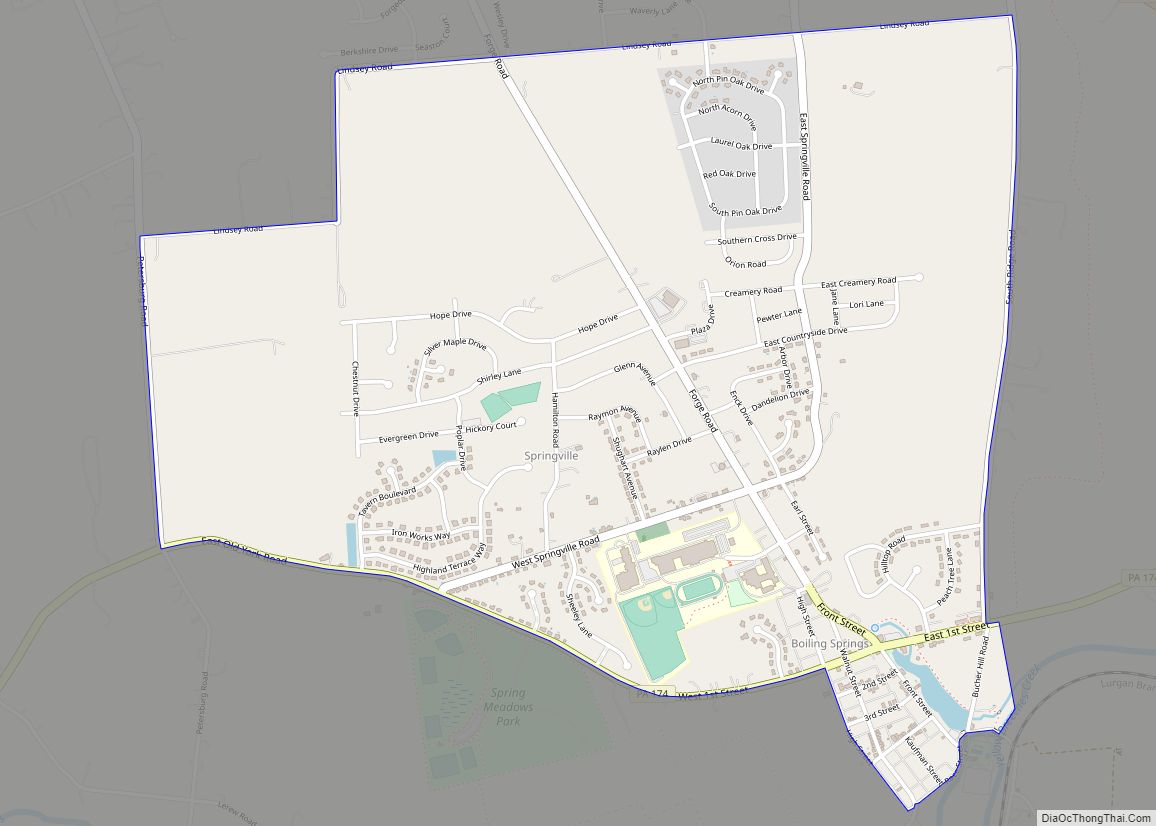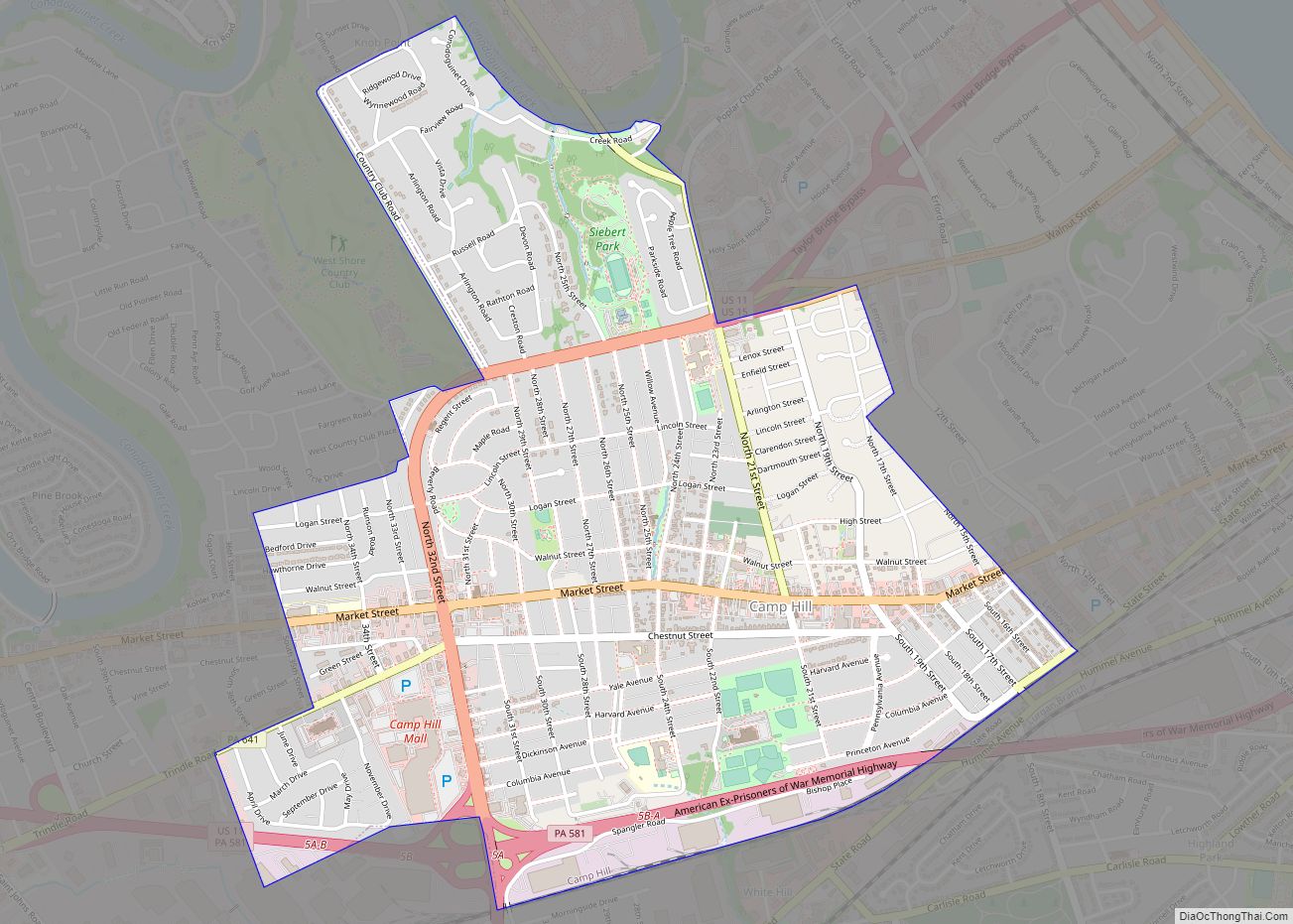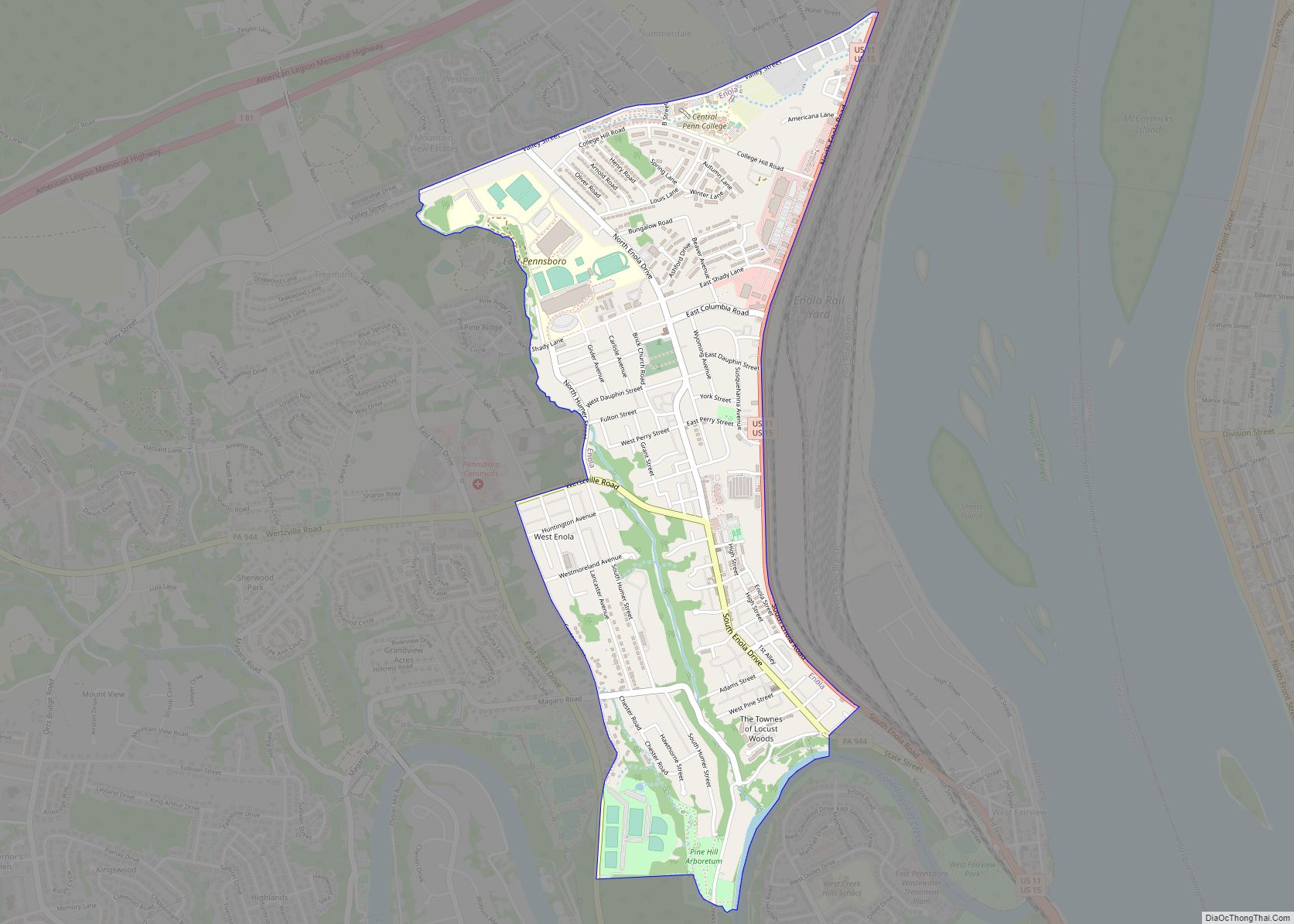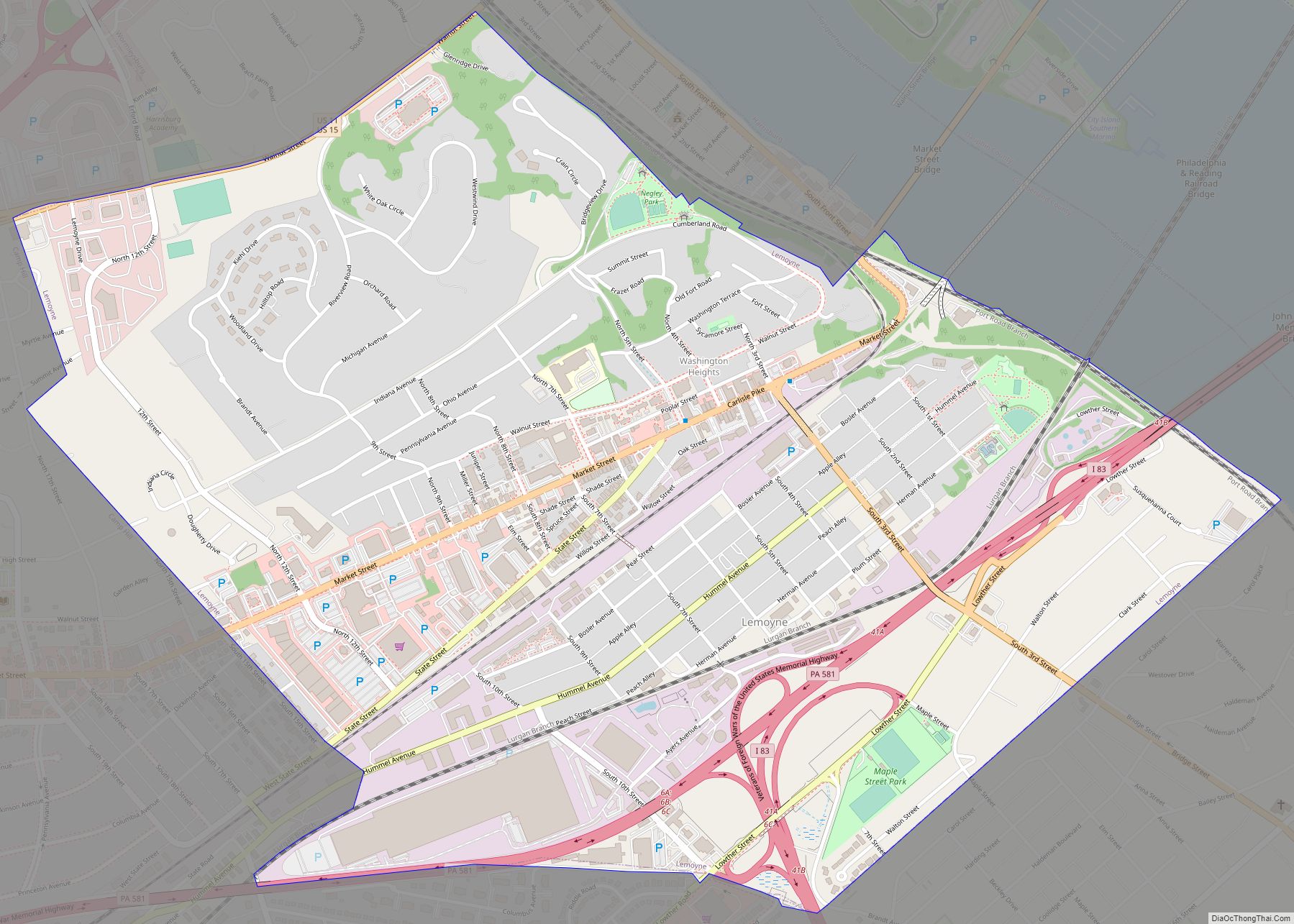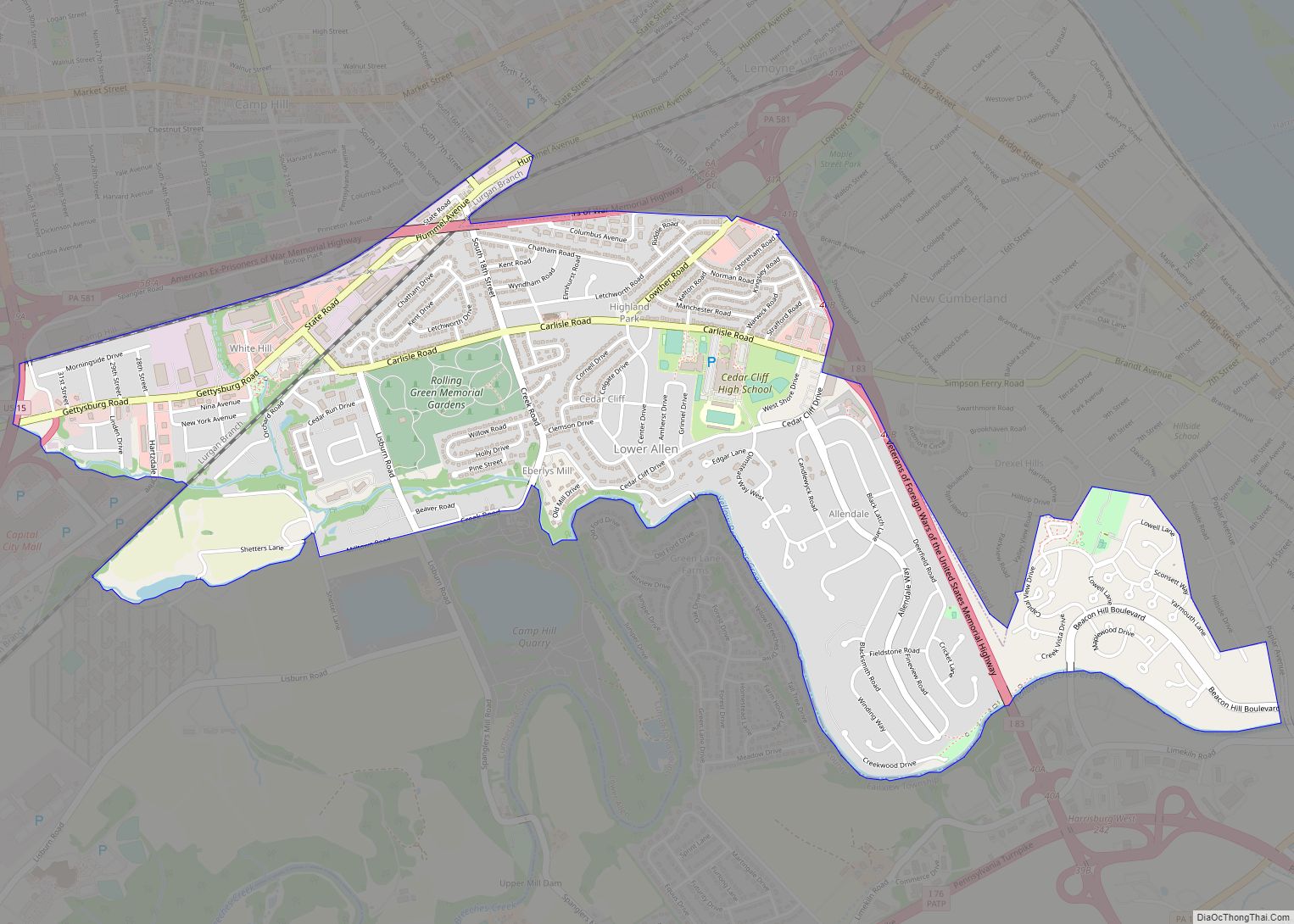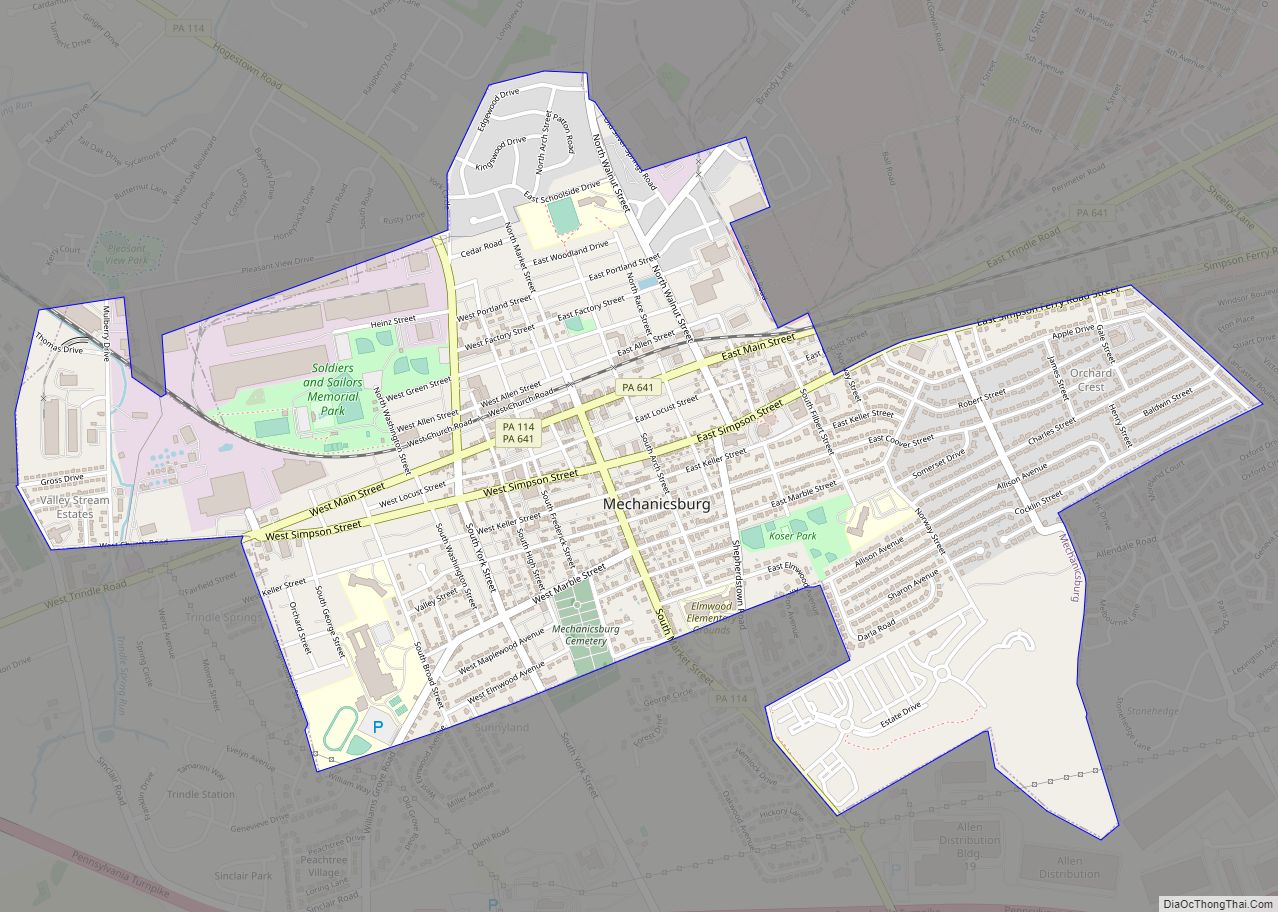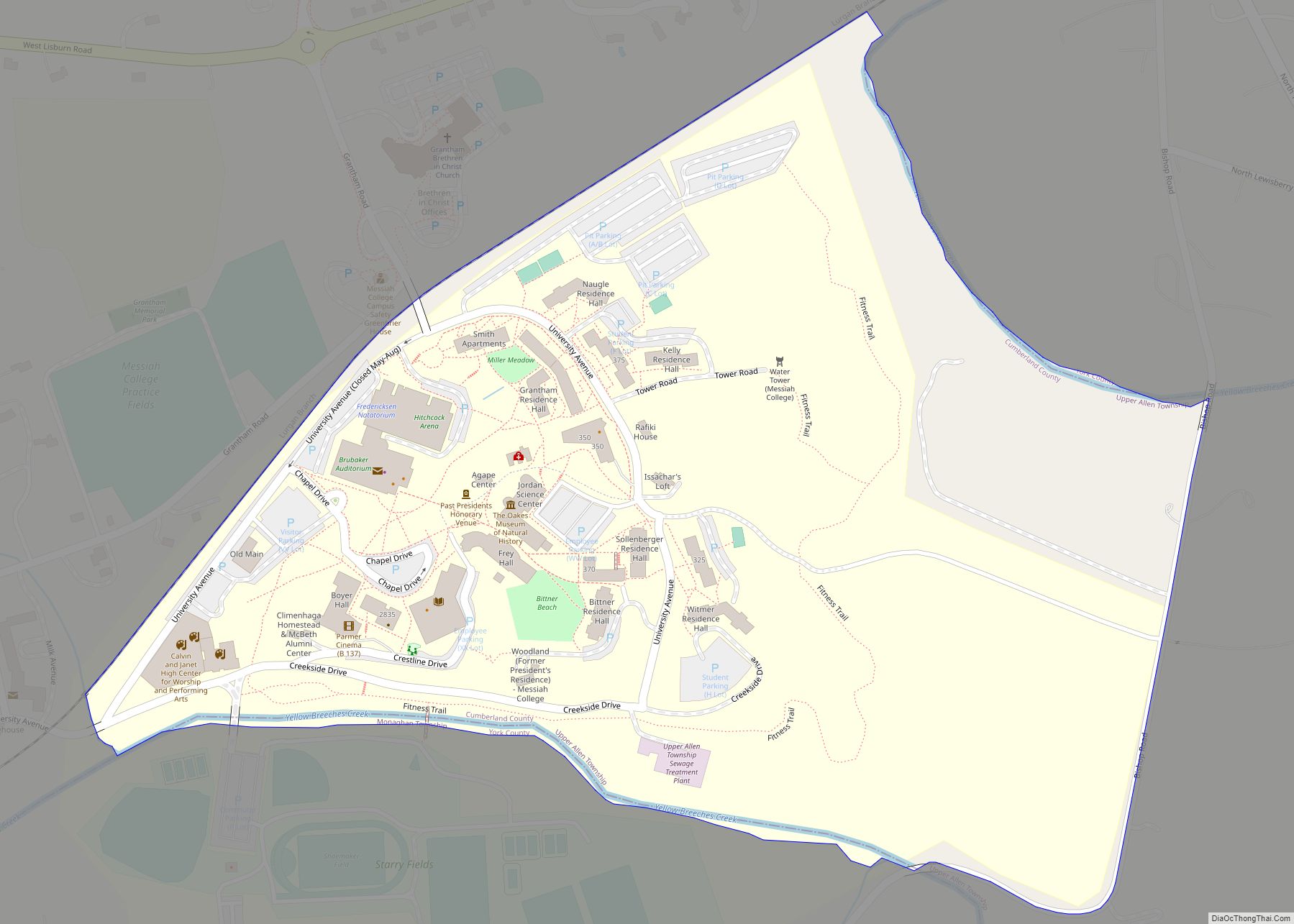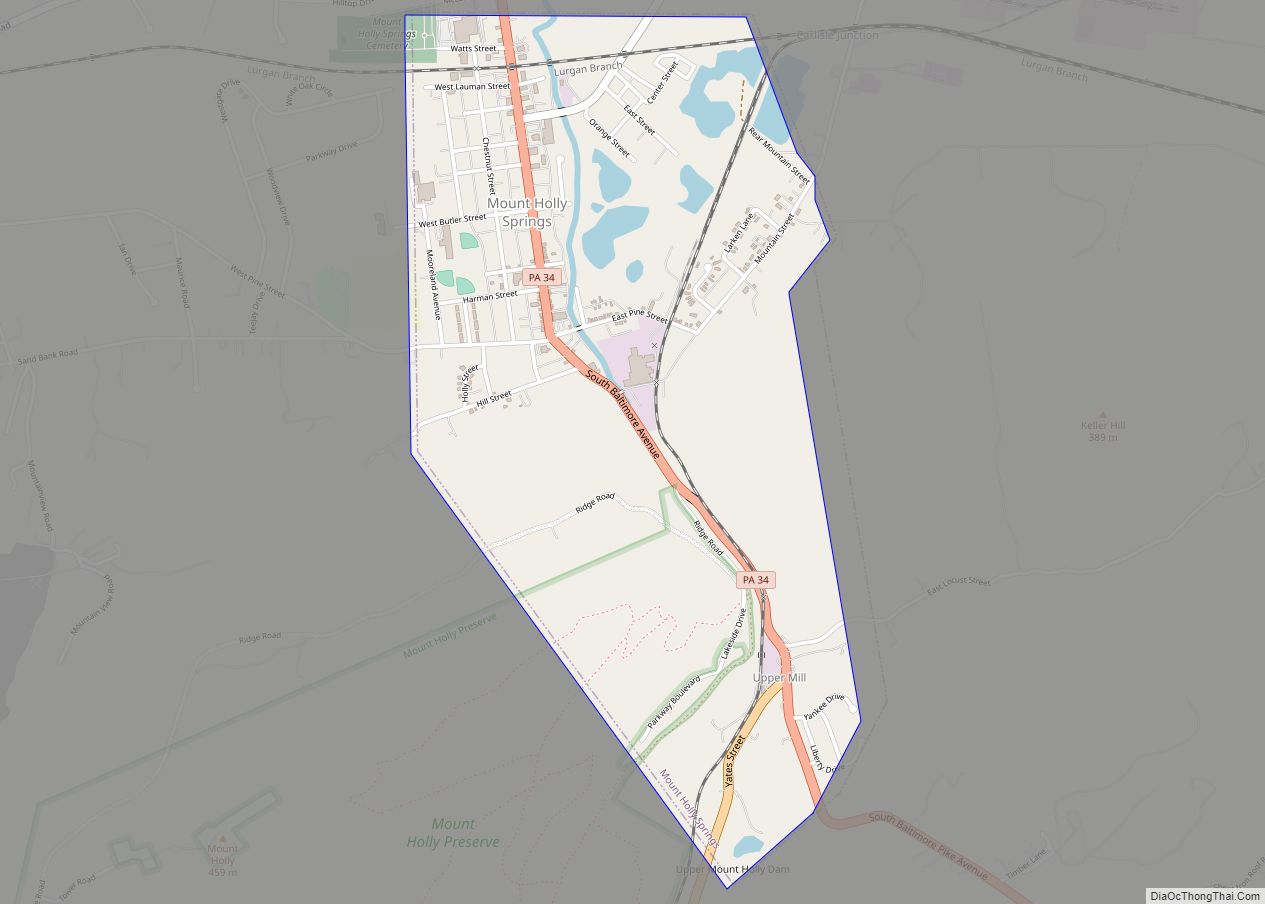Carlisle is a borough in and the county seat of Cumberland County, Pennsylvania, United States. Carlisle is located within the Cumberland Valley, a highly productive agricultural region. As of the 2020 census, the borough population was 20,118; including suburbs in the neighboring townships, 37,695 live in the Carlisle urban cluster. Carlisle is the smaller principal city of the Harrisburg–Carlisle metropolitan statistical area, which includes all of Cumberland, Dauphin, and Perry counties in South Central Pennsylvania.
The U.S. Army War College, located at Carlisle Barracks, prepares high-level military personnel and civilians for strategic leadership responsibilities. Carlisle Barracks ranks among the oldest U.S. Army installations and the most senior military educational institution in the United States Army. Carlisle Barracks is home of the United States Army Heritage and Education Center, an archives and museum complex open to the public. Carlisle also hosts Penn State Dickinson School of Law and Dickinson College.
| Name: | Carlisle borough |
|---|---|
| LSAD Code: | 21 |
| LSAD Description: | borough (suffix) |
| State: | Pennsylvania |
| County: | Cumberland County |
| Incorporated: | 1782 |
| Elevation: | 479 ft (146 m) |
| Total Area: | 5.43 sq mi (14.07 km²) |
| Land Area: | 5.42 sq mi (14.05 km²) |
| Water Area: | 0.01 sq mi (0.02 km²) |
| Total Population: | 20,118 |
| Population Density: | 3,709.07/sq mi (1,432.19/km²) |
| Area code: | 717 and 223 |
| FIPS code: | 4211272 |
| Website: | www.carlislepa.org |
Online Interactive Map
Click on ![]() to view map in "full screen" mode.
to view map in "full screen" mode.
Carlisle location map. Where is Carlisle borough?
History
The French-born fur trader James Le Tort may have built a cabin in the area as early as 1720. During the colonial era, Scots-Irish settlers began to settle in the Cumberland Valley beginning in the early 1730s. The settlement of Carlisle, at the intersection of several Indigenous trails, was designated by the Pennsylvania assembly and the Penn family in 1751 as the seat of Cumberland County (named for the county of the same name in England). American engineer John Armstrong Sr., a surveyor for the Penn family, laid the plan for the settlement of Carlisle in 1751. Armstrong Sr. settled there and fathered John Armstrong Jr. in 1758. They named the settlement after its sister town of the same name in Cumberland, England, and even designed its former jailhouse (which now serve as general government offices in the county) to resemble the Carlisle Citadel.
As a result of conflicts on the frontier with Native American tribes, a stockade was constructed in the settlement to protect against potential attacks in 1753. In 1755, the stockade was transformed into a fort, known as Fort Carlisle or Fort Lowther. In 1757, colonel-commandant John Stanwix—for whom Fort Stanwix in upstate New York was named—–established his headquarters in Carlisle, and was promoted to brigadier general on December 27. During the French and Indian War (the North American theater of the Seven Years’ War), the largely successful Forbes Expedition was organized in Carlisle in 1758; Henry Bouquet also organized a military expedition from the settlement in 1763 during Pontiac’s War.
The Pennsylvania guide, compiled by the Writers’ Program of the WPA in 1940, described the early history of Carlisle’s public square and the physical changes that had occurred by the first half of the 20th century, noting that the square, located at the
The settlement of Carlisle was largely supportive of the Patriot cause during the American Revolution, and numerous individuals from the settlement served in the Revolutionary War. Carlisle contains the home of lawyer James Wilson, who served as a representative to the Continental Congress; Wilson was a signer of the Declaration of Independence in addition to being one of the framers of the U.S. Constitution. The First Presbyterian Church, begun in 1757 and completed in 1770, is the oldest building in Carlisle, and was where the Rev. John Steel (known as “The Fighting Parson”) gave sermons in support of the Patriot cause during the American Revolution. The church was also where Pennsylvania settlers met on July 12, 1774, to sign a document protesting the Boston Port Act. A year later Carlisle supplied a contingent for a line infantry regiment of the Continental Army. Steel was named commander of the leading company of this group when they marched from Carlisle. No longer standing but marked by a historical marker is the home of Ephraim Blaine, Commissary General of Revolutionary Army. Also, no longer standing but commemorated, is the home of Gen. John Armstrong Sr., “Hero of Kittanning,” Revolutionary officer, and member of the Continental Congress. Still standing is the gun shop of Thomas Butler Sr., an Irish immigrant, who manufactured long rifles during the French and Indian War. He later became Chief Armorer for The First Continental Congress. He and his five sons served in the Revolutionary War and were known as “The Fighting Butlers. His eldest son was Richard Butler (general).
Carlisle also served as a munitions depot during the American Revolutionary War. The depot was later developed into the United States Army War College at Carlisle Barracks. Revolutionary War legend Molly Pitcher died in the borough in 1832, and her body lies buried in the Old Public Graveyard. A hotel was built in her honor, called the Molly Pitcher Hotel; it has since been renovated to house apartments for senior citizens.
Carlisle was incorporated as a borough a few years after the war on April 13, 1782. Carlisle continued to play a part in the early development in the United States through the end of the century: In response to a planned march in favor of the United States Constitution in 1787, Anti-Federalists instigated a riot in Carlisle. A decade later, during the Whiskey Rebellion in 1794, the troops of Pennsylvania and New Jersey assembled in Carlisle under the leadership of President George Washington. While in Carlisle, the president worshiped in the First Presbyterian Church at the corner of Hanover Street and High Street.
Benjamin Rush, a signer of the Declaration of Independence, developed Carlisle Grammar School in 1773 and chartered it as Dickinson College—the first new college founded in the newly recognized United States. One of the college’s more famous alumni, the 15th U.S. president, James Buchanan, graduated in 1809. The Dickinson School of Law, founded in 1834 and affiliated then with Dickinson College, ranks as the fifth-oldest law school in the United States and the oldest law school in Pennsylvania.
On June 2, 1847, Carlisle was the site of the McClintock Slave Riot, which that broke out after a fugitive slave hearing at the courthouse; several of the fugitive slaves were able to escape during the fray with the help of Carlisle’s black residents, while one of the slave catchers later died of his wounds. A Dickinson College professor, John McClintock, was tried and acquitted for his role in the riot.
A general borough law of 1851 (amended in 1852) authorized a burgess and a borough council to administer the government of the borough of Carlisle.
Leading up to the American Civil War, Carlisle served as a stop on the Underground Railroad. During the war, an army of the Confederate States of America, under General Fitzhugh Lee, attacked and shelled the borough during the Battle of Carlisle on July 1, 1863, as part of the Gettysburg Campaign. A cannonball dent can still be seen on one of the columns of the historic county courthouse.
United States Army Lieutenant Richard Henry Pratt founded Carlisle Indian Industrial School in 1879 as the first federally supported school for American Indians off a reservation. The United States government maintained the school, housed at Carlisle Barracks as an experiment in educating Native Americans and teaching them to reject tribal culture and to adapt to white society. Pratt retired from the Army in 1903 and from supervising the school as its superintendent in 1904. Athletic hero Jim Thorpe entered the school in 1907 and joined its football team under coach Glenn “Pop” Warner in 1908. Playing halfback, Jim Thorpe led the team to startling upset victories over powerhouses Harvard, Army, and the University of Pennsylvania in 1911–12, bringing nationwide attention to the school. Marianne Moore taught there c. 1910. Carlisle Indian School closed in 1918.
Dickinson School of Law was chartered as an independent institution in 1890. Dickinson School of Law merged into the Pennsylvania State University in 1997 as Penn State Dickinson School of Law.
Carlisle was the original eastern terminus of the Pennsylvania Turnpike when it opened in October 1940.
The Carlisle Historic District, Carlisle Indian Industrial School, Hessian Powder Magazine, Carlisle Armory, and Old West, Dickinson College are listed on the National Register of Historic Places.
Carlisle Road Map
Carlisle city Satellite Map
Geography
Carlisle is located slightly northeast of the center of Cumberland County at 40°12′9″N 77°11′42″W / 40.20250°N 77.19500°W / 40.20250; -77.19500 (40.202553, −77.195016) at an elevation of 479 feet (146 m). The borough lies in the Cumberland Valley, a section of the Great Appalachian Valley, to the south of Conodoguinet Creek, a tributary of the Susquehanna River. Letort Spring Run, a tributary of Conodoguinet Creek, runs north through the eastern part of the borough.
Carlisle lies in south-central Pennsylvania, southwest of the intersection of Interstate 76 (the Pennsylvania Turnpike) and Interstate 81, roughly 20 miles (32 km) west-southwest of Harrisburg, the state capital. By road, it is approximately 80 mi (130 km) northwest of Baltimore and 124 mi (200 km) west-northwest of Philadelphia. According to the United States Census Bureau, Carlisle has a total area of 5.54 square miles (14.35 km), of which 5.53 square miles (14.33 km) is land and 0.01 square miles (0.02 km), or 0.14%, is water.
Climate
Carlisle has a humid continental climate (Köppen Dfa) with hot, humid summers and cool winters. The average temperature in Carlisle is 51.3 °F (10.7 °C) with temperatures exceeding 90 °F (32 °C) an average of 16 days a year and dropping below 32 °F (0 °C) an average of 119 days a year. On average, the borough receives 38.8 inches (986 mm) of precipitation annually. Snowfall averages 29.8 inches (757 mm) per year. On average, January is the coolest month, July is the warmest month, and September is the wettest month. The hottest temperature recorded in Carlisle was 102 °F (39 °C) in 1966; the coldest temperature recorded was −19 °F (−28 °C) in 1994.
See also
Map of Pennsylvania State and its subdivision:- Adams
- Allegheny
- Armstrong
- Beaver
- Bedford
- Berks
- Blair
- Bradford
- Bucks
- Butler
- Cambria
- Cameron
- Carbon
- Centre
- Chester
- Clarion
- Clearfield
- Clinton
- Columbia
- Crawford
- Cumberland
- Dauphin
- Delaware
- Elk
- Erie
- Fayette
- Forest
- Franklin
- Fulton
- Greene
- Huntingdon
- Indiana
- Jefferson
- Juniata
- Lackawanna
- Lancaster
- Lawrence
- Lebanon
- Lehigh
- Luzerne
- Lycoming
- Mc Kean
- Mercer
- Mifflin
- Monroe
- Montgomery
- Montour
- Northampton
- Northumberland
- Perry
- Philadelphia
- Pike
- Potter
- Schuylkill
- Snyder
- Somerset
- Sullivan
- Susquehanna
- Tioga
- Union
- Venango
- Warren
- Washington
- Wayne
- Westmoreland
- Wyoming
- York
- Alabama
- Alaska
- Arizona
- Arkansas
- California
- Colorado
- Connecticut
- Delaware
- District of Columbia
- Florida
- Georgia
- Hawaii
- Idaho
- Illinois
- Indiana
- Iowa
- Kansas
- Kentucky
- Louisiana
- Maine
- Maryland
- Massachusetts
- Michigan
- Minnesota
- Mississippi
- Missouri
- Montana
- Nebraska
- Nevada
- New Hampshire
- New Jersey
- New Mexico
- New York
- North Carolina
- North Dakota
- Ohio
- Oklahoma
- Oregon
- Pennsylvania
- Rhode Island
- South Carolina
- South Dakota
- Tennessee
- Texas
- Utah
- Vermont
- Virginia
- Washington
- West Virginia
- Wisconsin
- Wyoming
